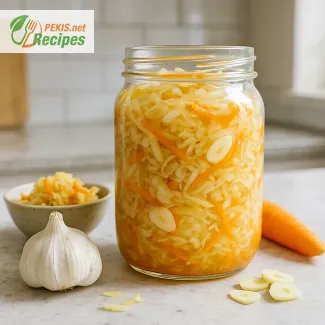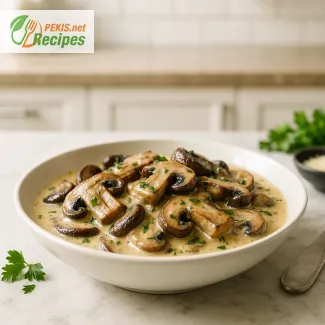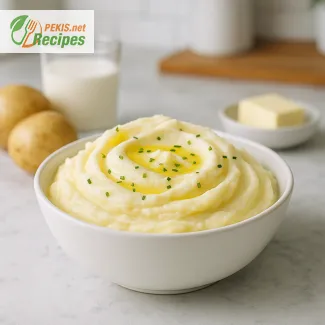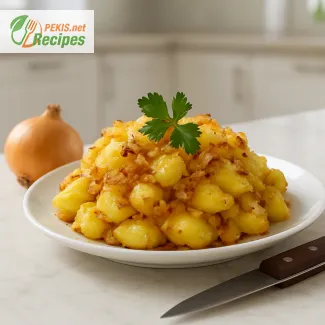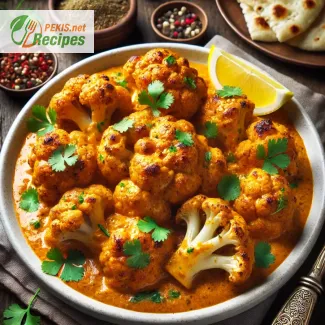
Roasted Cauliflower in Indian Sauce is a captivating dish that brings together the robust flavors of traditional Indian spices with the mild and naturally nutty taste of cauliflower. This dish is a culinary bridge between the vibrant spices of Indian cuisine and the comforting, hearty appeal of roasted vegetables, delivering both warmth and complexity in every bite. Whether enjoyed as a side dish or a vegetarian main, roasted cauliflower in Indian sauce is a versatile addition to any meal, balancing spice, texture, and depth of flavor.
Culinary Uses of Roasted Cauliflower in Indian Sauce
Roasted cauliflower in Indian sauce is often used as a satisfying side, complementing main dishes with bold flavors, or as a standalone dish that delights vegetarians and non-vegetarians alike. The high-fiber content of cauliflower and its low-calorie profile make it an excellent base for a dish that feels indulgent yet healthy. This dish works well alongside Indian flatbreads like naan or roti, as well as with steamed rice or quinoa to soak up the flavorful sauce. As a main course, it offers a hearty texture that can satiate without meat, making it a popular choice for vegetarian and vegan diets. The spices within the sauce bring both aromatic complexity and subtle heat, creating a dish that is as nourishing as it is delicious.
The Key Components
The sauce is the heart of this recipe, typically made with a base of tomato and coconut milk or yogurt to add creaminess. Spices like turmeric, cumin, coriander, and garam masala provide the warmth and depth typical of Indian flavors. Each spice not only contributes to the dish’s unique taste but also offers health benefits, from the anti-inflammatory properties of turmeric to the digestive benefits of cumin. Fresh ginger and garlic are frequently included, adding pungency and zing that elevate the dish’s aroma and flavor.
For those who appreciate a bit of heat, green chili or red chili powder can be added to the sauce, infusing the cauliflower with a gentle spiciness that enhances but does not overwhelm. Fresh cilantro often garnishes the dish, adding a burst of color and fresh, citrusy notes that balance the rich, roasted flavors.
Types and Variations of Roasted Cauliflower in Indian Sauce
There are numerous variations of this dish, each emphasizing different flavors and textures:
- Tandoori Roasted Cauliflower: This variation draws on the traditional tandoori spice blend, which includes paprika, coriander, cumin, and a hint of chili. The cauliflower is marinated in yogurt mixed with spices before being roasted, creating a slightly tangy and smoky profile. Often, a dash of lemon juice is added before serving to balance the spiciness and enhance the tandoori flavors.
- Masala Roasted Cauliflower: A traditional take that involves marinating the cauliflower in a thick masala sauce—a mixture of tomato paste, garlic, ginger, and spices. This version is heavier and usually has a saucier consistency, which works beautifully with basmati rice or Indian flatbreads. A masala roasted cauliflower can include additional vegetables like potatoes or peas to add variety in texture.
- Cauliflower Korma: Inspired by the creamy korma sauce, this variation uses coconut milk or cashew paste to create a mild, creamy base. Korma-style roasted cauliflower is ideal for those who prefer a less spicy version, as it emphasizes richness over heat. A hint of cardamom and cloves can be added to provide a sweet-spicy complexity characteristic of korma dishes.
- Spicy Vindaloo Cauliflower: For those who love bold heat, a vindaloo-inspired roasted cauliflower dish can be a thrilling option. Vindaloo sauces are known for their fiery spices, typically including mustard seeds, vinegar, and plenty of red chili powder. The cauliflower absorbs the tangy, spicy flavors, making it a great option for spice lovers who want a satisfying and intense flavor experience.
- Achari Cauliflower: This pickle-inspired variation includes spices used in traditional Indian pickles, like fenugreek, mustard seeds, and fennel seeds. Achari roasted cauliflower has a tangy, earthy flavor, with the spices providing a unique twist that stands out from other variations.
- Butter Cauliflower: Modeled after the famous butter chicken, this version includes a rich, buttery sauce with a hint of honey or sugar to balance the spices. It’s a luxurious version with a sweet-savory flavor, making it perfect for special occasions.
Nutritional Benefits of Roasted Cauliflower in Indian Sauce
Cauliflower is low in calories but high in fiber, vitamin C, vitamin K, and folate. Its high fiber content aids in digestion and promotes satiety, making this dish a great choice for those looking to enjoy a filling meal without excessive calories. The spices used in the sauce, particularly turmeric and ginger, are known for their anti-inflammatory and antioxidant properties, providing benefits beyond just taste. Additionally, the use of coconut milk or cashew cream in certain variations offers healthy fats that can contribute to satiety and a richer flavor profile.
Serving and Pairing Suggestions
Roasted cauliflower in Indian sauce pairs wonderfully with a variety of accompaniments, each adding a distinct element to the meal. Steamed basmati rice complements the saucy textures, while naan or paratha adds a chewy, slightly crisp texture that is perfect for scooping up the sauce. For a complete vegetarian meal, consider serving it alongside a lentil dal or spiced chickpeas, adding a protein component to the meal. A light cucumber raita or a mint yogurt can also provide a cooling contrast to the spices, refreshing the palate between bites.
Popularity and Appeal
Roasted cauliflower in Indian sauce has gained popularity worldwide as people embrace plant-based and healthy eating habits. Its versatility, nutritional profile, and ability to carry rich flavors have made it a favorite not only in Indian cuisine but also in fusion and international kitchens. The dish appeals to vegans, vegetarians, and omnivores alike, as it offers the complexity and satisfaction of a hearty main course without the need for animal-based ingredients.
Final Thoughts
Roasted cauliflower in Indian sauce is a celebration of spices and textures, bringing out the best in cauliflower through the process of roasting and careful seasoning. With its wide range of variations, from tandoori to korma-inspired versions, this dish proves to be adaptable to different taste preferences, allowing for creativity while remaining grounded in the essence of Indian flavors. Whether you’re looking for a robust side dish, a meatless main, or simply a flavorful addition to your menu, roasted cauliflower in Indian sauce delivers a culinary experience that is rich, comforting, and packed with health benefits.
Step 1: Prepare and Roast the Cauliflower
- Preheat the oven to 200°C (400°F).
- Place the cauliflower florets in a large mixing bowl. Add olive oil, turmeric, cumin, and salt. Toss well to evenly coat the cauliflower with spices.
- Arrange the florets in a single layer on a baking sheet lined with parchment paper. Roast for 20-25 minutes, or until the cauliflower is golden brown and tender.
Step 2: Prepare the Indian Sauce
- While the cauliflower roasts, heat olive oil in a large skillet over medium heat.
- Add the chopped onion and sauté for 5-6 minutes until soft and translucent.
- Add the grated ginger and minced garlic, cooking for another 1-2 minutes until fragrant.
- Add the ground cumin, coriander, turmeric, and garam masala to the skillet. Stir for 1-2 minutes to toast the spices.
- Pour in the canned diced tomatoes and stir well, cooking for 5 minutes until the sauce thickens slightly.
- Add the coconut milk, lemon juice, and salt, stirring to combine. Let the sauce simmer on low heat for 8-10 minutes, stirring occasionally.
Step 3: Combine and Serve
- Once the cauliflower is done roasting, add it to the sauce, stirring gently to coat each piece with the Indian sauce.
- Garnish with freshly chopped cilantro and serve with lemon wedges on the side.
This recipe brings together the earthy taste of roasted cauliflower with the warm, aromatic spices of traditional Indian cuisine. It’s perfect as a vegetarian main or as a flavorful side, pairing beautifully with basmati rice or naan. Enjoy!
The Roasted Cauliflower in Indian Sauce is not only a flavorful dish but also a nutritionally beneficial one, packed with essential vitamins, minerals, and compounds that contribute to health and well-being. Here is a closer look at how each component of the recipe supports our body:
Cauliflower
Cauliflower is the star ingredient, providing a robust nutritional profile:
- Vitamins: Cauliflower is high in Vitamin C, an antioxidant that boosts the immune system, supports collagen production, and aids in skin health. One serving covers a significant portion of daily Vitamin C needs, helping protect cells from oxidative stress.
- Vitamin K: This vitamin is essential for blood clotting and bone health, playing a key role in preventing conditions like osteoporosis.
- B-Vitamins: Cauliflower contains folate (Vitamin B9), critical for cell function and tissue growth, especially important during pregnancy for fetal development.
Fiber: With approximately 6 grams of fiber per serving, cauliflower aids in digestion, promoting gut health, and maintaining balanced blood sugar levels. The fiber content contributes to satiety, which can assist in weight management by reducing hunger.
Antioxidants: Beyond Vitamin C, cauliflower is rich in plant-based compounds like glucosinolates and isothiocyanates. These antioxidants support liver health and have been shown to reduce inflammation and help the body detoxify harmful substances.
Olive Oil
Olive oil is a source of healthy monounsaturated fats:
- Heart Health: Olive oil is linked to lower levels of LDL (bad cholesterol) and higher HDL (good cholesterol) levels, which contributes to a reduced risk of heart disease.
- Vitamin E: This fat-soluble vitamin acts as a potent antioxidant, protecting cells from oxidative damage and supporting skin health.
- Anti-inflammatory Properties: The polyphenols in olive oil have been shown to reduce inflammation in the body, which can lower the risk of chronic diseases.
Spices (Turmeric, Cumin, Coriander, and Garam Masala)
Indian spices not only add vibrant flavor but also deliver impressive health benefits:
- Turmeric: Known for its compound curcumin, turmeric is one of the most powerful natural anti-inflammatory agents. Curcumin supports joint health, may reduce symptoms of arthritis, and has antioxidant effects that protect against cellular damage.
- Cumin: This spice aids digestion by stimulating enzymes necessary for breaking down nutrients, which can help prevent bloating and indigestion. Cumin also has antimicrobial properties, supporting gut health and immune defense.
- Coriander: Coriander seeds have a cooling effect on the body and support digestion. Rich in Vitamin C, Vitamin K, and dietary fiber, coriander aids in heart health and immune support.
- Garam Masala: This spice blend usually includes cloves, cinnamon, cardamom, and black pepper. These spices are known for their digestive benefits and can help regulate blood sugar levels. For example, cinnamon is linked to reduced blood sugar spikes, while black pepper enhances the absorption of curcumin from turmeric.
Coconut Milk
Coconut milk contributes a creamy texture and a nutritional boost:
- Healthy Fats: Coconut milk provides medium-chain triglycerides (MCTs), which are easily absorbed and used by the body for energy. MCTs are also linked to improved metabolism and cognitive function.
- Minerals: Coconut milk contains magnesium, potassium, and iron, which are essential for muscle function, hydration, and oxygen transport in the body.
- Immune Support: The lauric acid in coconut milk has antibacterial, antiviral, and antifungal properties, which may help support immune health and fight infections.
Onion, Garlic, and Ginger
These aromatic vegetables are essential to the dish’s flavor and contribute numerous health benefits:
- Onion: Rich in Vitamin C, B6, and folate, onions offer antioxidant properties that support immune function and reduce inflammation. They are also high in quercetin, an antioxidant linked to lower blood pressure and improved heart health.
- Garlic: Known for its compound allicin, garlic has powerful immune-boosting properties. It helps lower cholesterol levels, supports heart health, and has antimicrobial effects.
- Ginger: Known for aiding digestion, ginger contains gingerol, a bioactive compound with anti-inflammatory and antioxidant effects. It can relieve nausea, reduce muscle soreness, and help lower blood sugar levels.
Tomatoes
Tomatoes serve as the base for the sauce and bring their own set of benefits:
- Vitamin C: Just like cauliflower, tomatoes are high in Vitamin C, supporting immune health and collagen production.
- Lycopene: This powerful antioxidant gives tomatoes their red color and is linked to a reduced risk of heart disease and certain cancers, particularly prostate cancer.
- Potassium: This mineral is essential for heart health, helping regulate blood pressure and reducing the risk of cardiovascular disease.
Lemon Juice
Lemon juice adds a zesty brightness and is rich in Vitamin C, further boosting the antioxidant content of the dish. The acidity helps balance the flavors and aids in the digestion of the meal.
Overall Health Impact
This recipe is well-rounded in essential vitamins, minerals, and beneficial fats. It is naturally low in calories, high in fiber, and offers plant-based fats, making it supportive of heart health, digestion, and immune function. The dish is suitable for various diets, including vegetarian and vegan, and can fit into a balanced meal plan focused on whole foods and nutrient density. By combining diverse spices and ingredients, this dish is both nourishing and vibrant, contributing positively to overall health and well-being.
Roasted Cauliflower in Indian Sauce is a nourishing, plant-based dish that can be included on the menu as a weekly staple, especially for those seeking a diet rich in vegetables, fiber, and beneficial spices. Given its nutrient profile and low-calorie content, this meal is an excellent choice for a balanced diet and can comfortably serve as a main course or a side, bringing variety and flavor without excessive calories or saturated fats.
Frequency and Dietary Recommendations
Incorporating this dish once a week aligns well with dietary goals focused on heart health, digestive wellness, and weight management. The fiber content from cauliflower and the antioxidant properties of spices support gut health and immune function. Including a dish like this regularly can contribute to reaching daily vegetable servings, providing essential vitamins and minerals that are beneficial for skin health, metabolic function, and overall vitality.
For individuals on vegetarian or vegan diets, this dish can be a satisfying main course, as the ingredients work together to provide essential nutrients, including Vitamin C, Vitamin K, and beneficial fats from coconut milk and olive oil. Those on a Mediterranean diet or looking to reduce meat intake may also find it a flavorful and beneficial addition to their meal rotation.
Additional Tips and Serving Suggestions
- Pairing Options: To create a complete meal, serve this dish with whole grains like brown rice, quinoa, or farro for added protein and fiber. Whole grains enhance the nutrient balance of the dish, making it more filling and protein-rich.
- Adjusting Spice Levels: The spice profile in this recipe can be adjusted according to taste. Those who prefer milder flavors can reduce the amount of garam masala or chili, while spice lovers can add a pinch of chili powder or fresh green chili for a bit more heat.
- Storage and Meal Prep: Roasted cauliflower in Indian sauce stores well in the refrigerator for up to 3 days. Consider making a larger batch for meal prep, as it can be reheated without losing flavor. The sauce tends to deepen in taste as it sits, making leftovers even more flavorful.
- Health Modifications: For a lighter version, reduce the amount of coconut milk, opting for a lower-fat alternative like almond or oat milk, or use half coconut milk and half vegetable broth. This modification will reduce calories and fat without sacrificing much of the dish's creamy texture.
With these small adjustments and a flexible pairing approach, roasted cauliflower in Indian sauce can seamlessly fit into a balanced and flavorful diet, offering both satisfaction and nutritional benefits.
For Roasted Cauliflower in Indian Sauce, the potential allergens include:
- Dairy: Often found in yogurt used for marinating. Substitute with coconut milk or a dairy-free yogurt to eliminate this allergen.
- Coconut: Present in coconut milk. Replace with almond milk or cashew cream if there’s a coconut allergy.
- Gluten: Typically in naan bread served alongside. Opt for gluten-free bread or rice.
- Mustard: Sometimes in spice blends. Use a mustard-free blend or omit mustard entirely.
These substitutions can help make the dish allergen-free.
